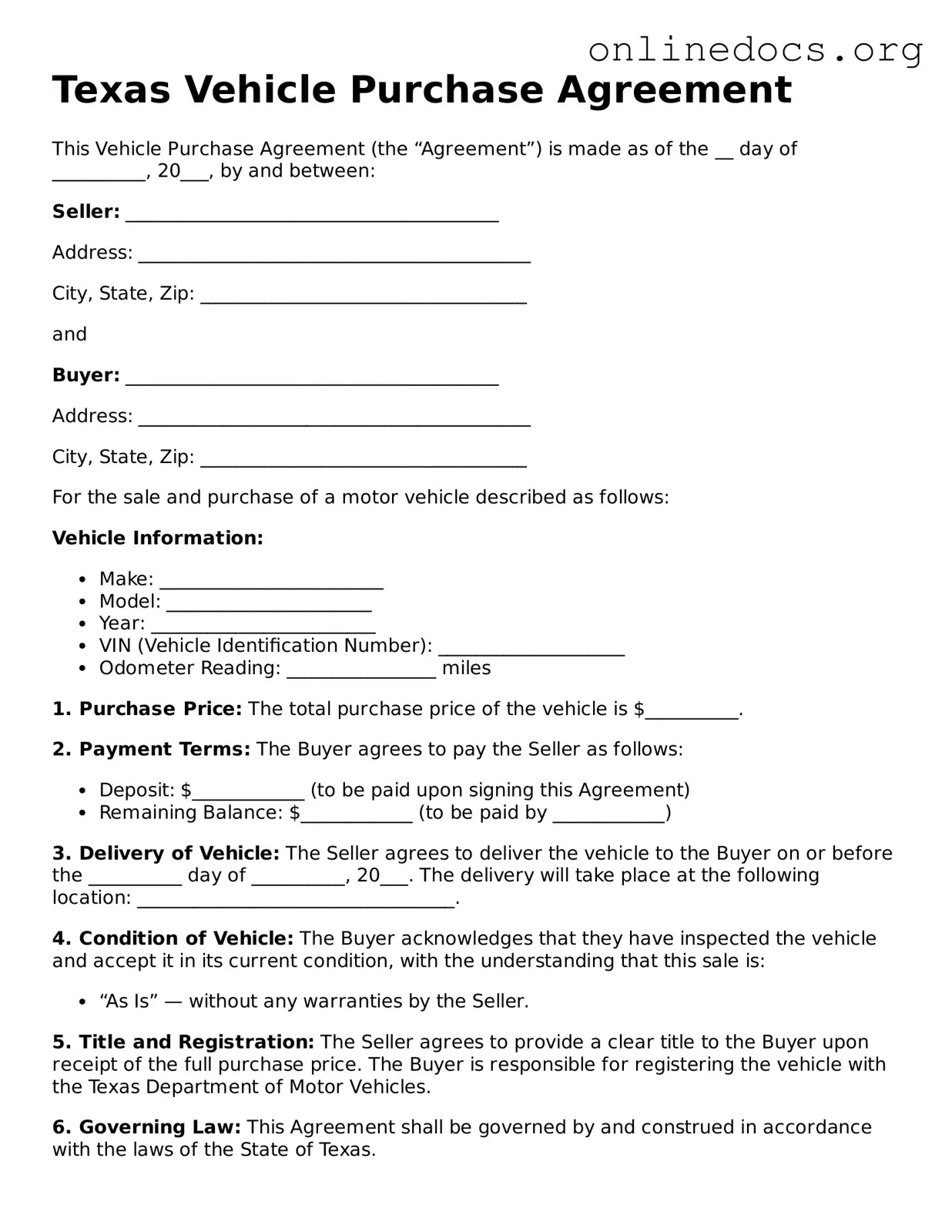The Texas Vehicle Purchase Agreement form shares similarities with the Bill of Sale. Both documents serve as proof of a transaction between a buyer and a seller. A Bill of Sale typically outlines the details of the vehicle, such as its make, model, year, and Vehicle Identification Number (VIN). This document is essential for transferring ownership and can be required for registration purposes. Just like the Vehicle Purchase Agreement, a Bill of Sale may also include information about the sale price and any warranties or guarantees provided by the seller.
Another document akin to the Texas Vehicle Purchase Agreement is the Lease Agreement. While a Vehicle Purchase Agreement focuses on the sale of a vehicle, a Lease Agreement outlines the terms under which a vehicle is rented for a specified period. Both documents detail the obligations of the parties involved, including payment terms, maintenance responsibilities, and conditions for termination. The clarity provided in both agreements helps prevent disputes and ensures that both parties understand their rights and responsibilities.
The Purchase Order is another document that resembles the Texas Vehicle Purchase Agreement. This document is often used in business transactions to confirm an order for goods or services. Like the Vehicle Purchase Agreement, it includes details about the item being purchased, the price, and the terms of payment. Both documents serve as formal records of the agreement between the buyer and seller, ensuring that both parties have a clear understanding of the transaction's specifics.
In addition, the Sales Contract is similar to the Texas Vehicle Purchase Agreement. A Sales Contract is a legally binding agreement between a buyer and seller for the sale of goods or services. It outlines the terms of the sale, including the price, delivery conditions, and any contingencies. Both documents aim to protect the interests of both parties and provide a framework for resolving any potential disputes that may arise during the transaction.
For those considering a formal arrangement, understanding the particulars of a Power of Attorney document can be crucial. By utilizing a tailored blank Power of Attorney form, you can grant essential authority to a designated person, often simplifying complex decision-making processes in significant matters. To start this important journey, explore our resource on the comprehensive Power of Attorney options.
The Financing Agreement also bears resemblance to the Vehicle Purchase Agreement. This document outlines the terms under which a buyer finances the purchase of a vehicle. It includes details about the loan amount, interest rate, payment schedule, and any collateral involved. Like the Vehicle Purchase Agreement, a Financing Agreement ensures that both parties understand their obligations and rights throughout the financing process.
The Title Transfer document is another important form that relates closely to the Texas Vehicle Purchase Agreement. This document is essential for transferring ownership of a vehicle from one party to another. It includes information such as the buyer's and seller's names, the vehicle's details, and signatures from both parties. Both documents work together to facilitate a smooth transfer of ownership, ensuring that the new owner can legally register and operate the vehicle.
Lastly, the Warranty Document is comparable to the Texas Vehicle Purchase Agreement in that it outlines the guarantees provided by the seller regarding the vehicle's condition and performance. This document specifies what is covered under the warranty, the duration, and any limitations or exclusions. Both documents aim to provide transparency and protect the interests of the buyer, ensuring they are aware of any assurances made by the seller regarding the vehicle.
